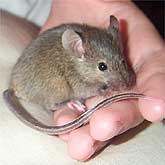Why Aren't Mice More Like Us?
 The sequence of the human genome was published two years ago, and recently, the sequence of the mouse genome was published. Amazingly, 99% of mouse genes have a counterpart in people. So why are they so small and furry, while we are big and hairless and so much smarter?
The sequence of the human genome was published two years ago, and recently, the sequence of the mouse genome was published. Amazingly, 99% of mouse genes have a counterpart in people. So why are they so small and furry, while we are big and hairless and so much smarter?
Most likely the answer lies in how the 30,000 or so genes are used. Genes tell how to make proteins, which do the actual work of running a cell. They also contain information saying when to make the proteins and how much to make, which cells to make them in, and when to stop making them. This information differs quite a lot between mice and people.
Nevertheless, their great similarity to us makes mice wonderfully useful for finding out things about ourselves. In many ways, they are ‘man's best friend.’ We can do experiments with mice that are ethically unacceptable to do with people -- for example destroy genes one at a time to see what happens. There are now several thousand strains of mice that carry a deleted gene. These mice can serve as models for people who may suffer from diseases caused by malfunctions of the deleted genes. Since 90% of the genes associated with disease are identical in mice and humans, these ‘knockout’ mice can be extremely useful in tracking down the causes and possible cures for human diseases.
About the Author
Sandy Becker, MA
 Sandy Becker received a BA in history from Pomona College. She then earned two MAs in Biology, and now has 25 years of experience in developmental biology research, working with mouse embryonic stem cells. Sandy began writing science articles about ten years ago to share her knowledge of science. She is currently studying for her third MA, in science journalism.
Sandy Becker received a BA in history from Pomona College. She then earned two MAs in Biology, and now has 25 years of experience in developmental biology research, working with mouse embryonic stem cells. Sandy began writing science articles about ten years ago to share her knowledge of science. She is currently studying for her third MA, in science journalism.


